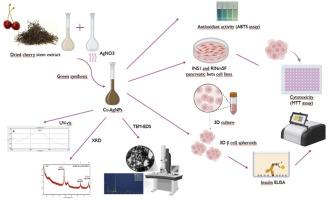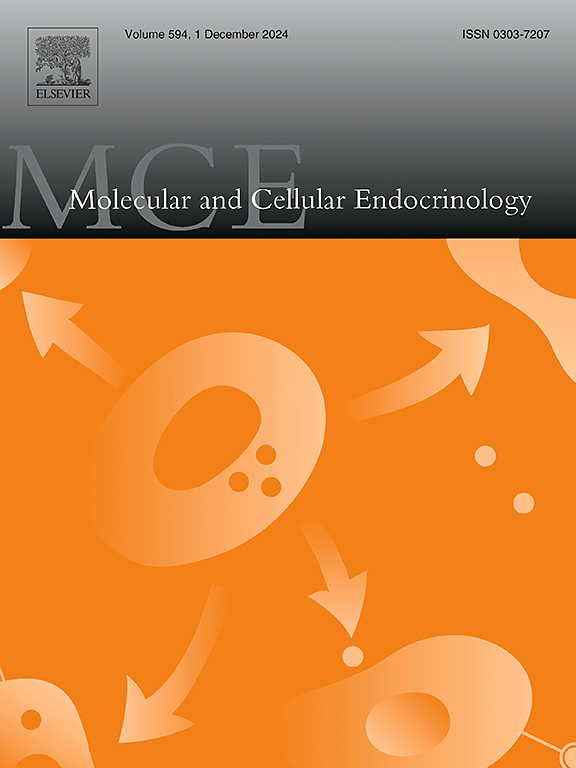三维胰腺β细胞模型揭示绿色合成银纳米颗粒促进胰岛素分泌的潜力。
IF 3.6
3区 医学
Q2 CELL BIOLOGY
引用次数: 0
摘要
本研究利用樱桃茎水提取物(Cs-AgNPs)合成了纳米银颗粒,并在三维胰腺β细胞模型中评估了它们的理化性质、对胰腺β细胞系的细胞毒作用、抗氧化活性以及它们促进胰岛素分泌的潜力。以樱桃茎提取物和硝酸银为原料合成了Cs-AgNPs,并通过颜色变化和紫外-可见分光光度法进行了验证。通过EDS、TEM和XRD等手段对纳米颗粒进行了表征,结果表明纳米颗粒呈球形,具有晶体结构,粒径范围为10.93 ~ 31.18 nm,平均粒径为26.67 nm。生物学评估显示对胰腺β细胞系有剂量依赖性的细胞毒性作用,≥2 μg/mL的INS-1细胞和≥5 μg/mL的RINm5F细胞活性降低。ABTS法证实其抗氧化活性,IC50值为78.81 μg/mL。3D胰腺β细胞球体的功能研究显示,RINm5F细胞的胰岛素分泌显著增加1.6倍(p = 0.0166), INS-1细胞的胰岛素分泌适度增加1.2倍。这些结果突出了Cs-AgNPs的抗氧化特性和促进胰岛素分泌的潜力,表明它们在糖尿病相关应用方面的前景。建议进一步研究以探索其治疗效益并扩大其生物医学用途。本文章由计算机程序翻译,如有差异,请以英文原文为准。

Three-dimensional (3D) pancreatic β-cell models reveal insulin-secretion enhancing potential of green synthesized silver nanoparticles
This study synthesized silver nanoparticles using cherry stem aqueous extract (Cs-AgNPs) and evaluated their physicochemical properties, cytotoxic effects on pancreatic β-cell lines, antioxidant activity, and their potential to enhance insulin secretion in 3D pancreatic β-cell models. Cs-AgNPs were synthesized via a reaction between cherry stem extract and silver nitrate, confirmed through color change and UV–Vis spectrophotometry. Characterization using EDS, TEM, and XRD revealed spherical nanoparticles with a crystalline structure, sizes ranging from 10.93 to 31.18 nm, and an average size of 26.67 nm. Biological assessments showed dose-dependent cytotoxic effects on pancreatic β-cell lines, with reduced viability observed at ≥2 μg/mL for INS-1 cells and ≥5 μg/mL for RINm5F cells. Antioxidant activity was confirmed through ABTS assay, with an IC50 value of 78.81 μg/mL. Functional studies on 3D pancreatic β-cell spheroids revealed a significant 1.6-fold increase in insulin secretion in RINm5F cells (p = 0.0166) and a modest 1.2-fold increase in INS-1 cells. The results highlight the antioxidant properties and insulin secretion enhancement potential of Cs-AgNPs, suggesting their promise for diabetes-related applications. Further research is recommended to explore their therapeutic benefits and expand their biomedical utility.
求助全文
通过发布文献求助,成功后即可免费获取论文全文。
去求助
来源期刊

Molecular and Cellular Endocrinology
医学-内分泌学与代谢
CiteScore
9.00
自引率
2.40%
发文量
174
审稿时长
42 days
期刊介绍:
Molecular and Cellular Endocrinology was established in 1974 to meet the demand for integrated publication on all aspects related to the genetic and biochemical effects, synthesis and secretions of extracellular signals (hormones, neurotransmitters, etc.) and to the understanding of cellular regulatory mechanisms involved in hormonal control.
 求助内容:
求助内容: 应助结果提醒方式:
应助结果提醒方式:


